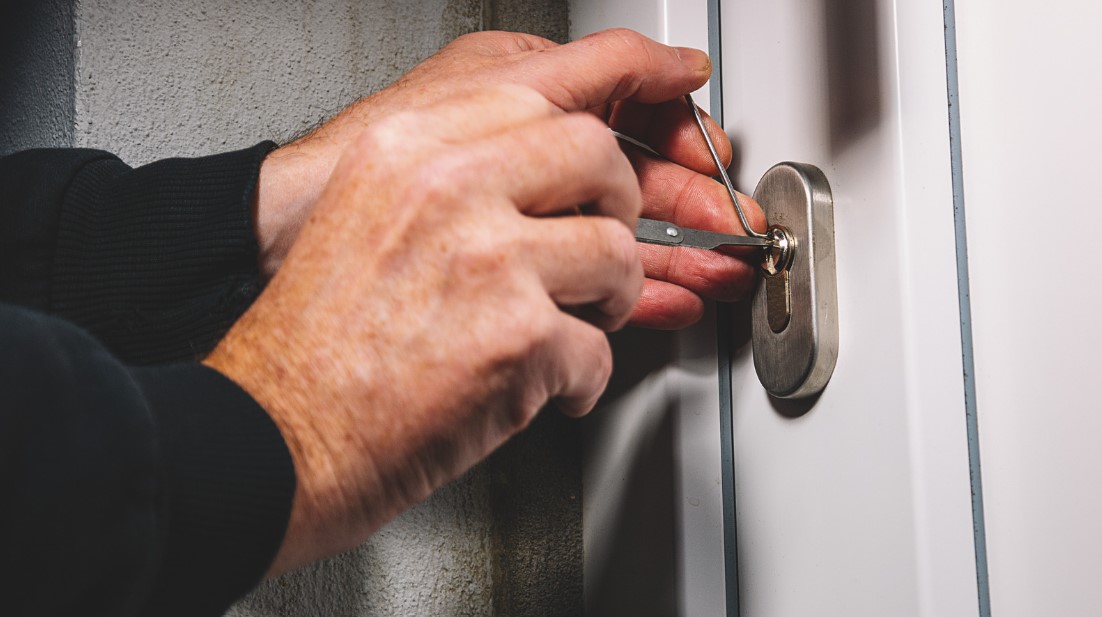Welcome to our quick guide on how to pick a lock! Whether you’ve misplaced your key or simply want to understand the inner workings of locks, this article will provide you with essential lock picking tips and locksmith techniques.
In this article, we’ll provide you with step-by-step instructions on how to pick a lock, along with lock picking techniques for beginners and professionals. Join us on this enlightening journey as we uncover the secrets of lock picking!
How to Pick a Lock? – Step-by-Step
Picking a lock may seem like a daunting task, but with the right approach and tools, it can be done effectively and safely. Follow these step-by-step instructions to master the art of lock picking.
- Lubricate the lock: Before you begin, it’s important to ensure that the lock is lubricated for smooth functioning. Apply a small amount of lubricant, such as graphite, to the keyway.
- Insert the tension wrench: Insert a tension wrench into the bottom of the keyway and apply slight pressure in the direction you would turn the key. This tension will create a binding effect on the lock’s pins.
- Insert the pick: Insert a lock pick into the top of the keyway and gently push it upward. Begin investigating the pins by applying light pressure to test their resistance. Pay close attention to how each pin reacts.
- Identify the binding pin: As you push up on the pins, you may encounter one that feels different than the others. This pin is known as the binding pin and is the key to unlocking the lock. It will provide more resistance when pushed up.
- Set the binding pin: Gradually lift the binding pin with the pick while maintaining tension on the wrench. Once the binding pin sets into place, you’ll feel a slight click or movement. Keep the pin in the set position.
- Repeat for each pin: Continue setting each pin one by one, repeating the process of lifting and maintaining tension. Be patient and gentle with your movements, allowing each pin to set into place before moving on to the next.
- Apply more pressure: Once all pins are set, apply more pressure with the tension wrench. Keep the wrench steady and turn it in the direction you would turn a key. The lock should release and open.
By following these step-by-step instructions, you can effectively pick a lock and gain access when needed. Remember to always use this skill responsibly and within legal boundaries.
| Steps | Lock Picking Tools |
|---|---|
| Lubricate the lock | – Lock lubricant – Tension wrench – Lock pick |
| Insert the tension wrench | – Lock pick set – Graphite lubricant |
| Insert the pick | – Raking tool – Tension wrench |
| Identify the binding pin | – Lock pick set – Tension wrench |
| Set the binding pin | – Tension wrench – Lock pick |
| Repeat for each pin | – Lock pick set – Tension wrench |
| Apply more pressure | – Tension wrench – Graphite lubricant |
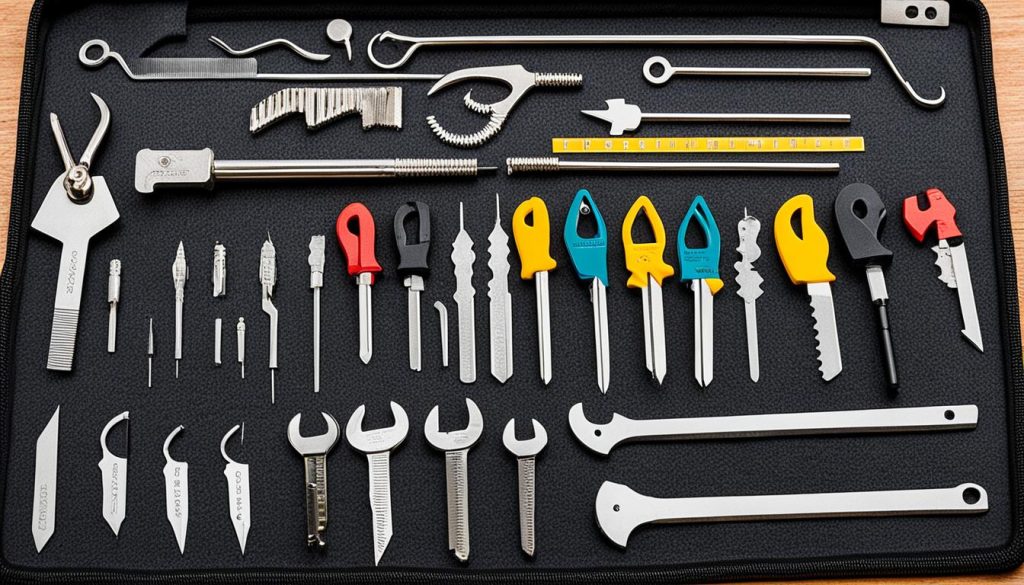
Lock Picking Techniques for Beginners
For beginners interested in learning lock picking, there are simple techniques that can be practiced using common household items. These techniques, although basic, can provide a good foundation for developing lock picking skills. With practice, beginners can become proficient in the art of lock picking.
Using a Bobby Pin
A bobby pin can be a versatile tool for lock picking, especially for beginners. To start, straighten out the bobby pin and bend the end of it to create a makeshift tension wrench. Insert the tension wrench into the bottom of the keyway and apply slight upward pressure.
Next, take the remaining straight portion of the bobby pin and bend it again at a 90-degree angle. This will serve as the lock pick. Insert the pick into the top of the keyway and gently probe the pins, applying light pressure to test their resistance.
Beginners should focus on manipulating each pin individually, gradually lifting them with the pick until they set into place. This requires finesse and patience, but with practice, beginners can successfully pick locks using a bobby pin.
Using a Hairpin or Paperclip
Another option for beginners is using a hairpin or a paperclip as a lock picking tool. Similar to the bobby pin technique, a hairpin or paperclip can be manipulated to serve as a tension wrench and lock pick.
Start by bending the hairpin or paperclip to create a tension wrench with an L-shaped end. Insert the tension wrench into the bottom of the keyway and apply gentle upward pressure. This helps create tension within the lock.
Using the remaining portion of the hairpin or paperclip, bend it again at a 90-degree angle to create the lock pick. Insert the pick into the top of the keyway and feel for the pins. With careful manipulation and lifting, beginners can set the pins and unlock the lock.
Practice Makes Perfect
These lock picking techniques for beginners require practice and patience to master. It’s important to understand the mechanics of the lock and develop a feel for the pins. With dedicated practice sessions, beginners can hone their skills and become more proficient in lock picking.
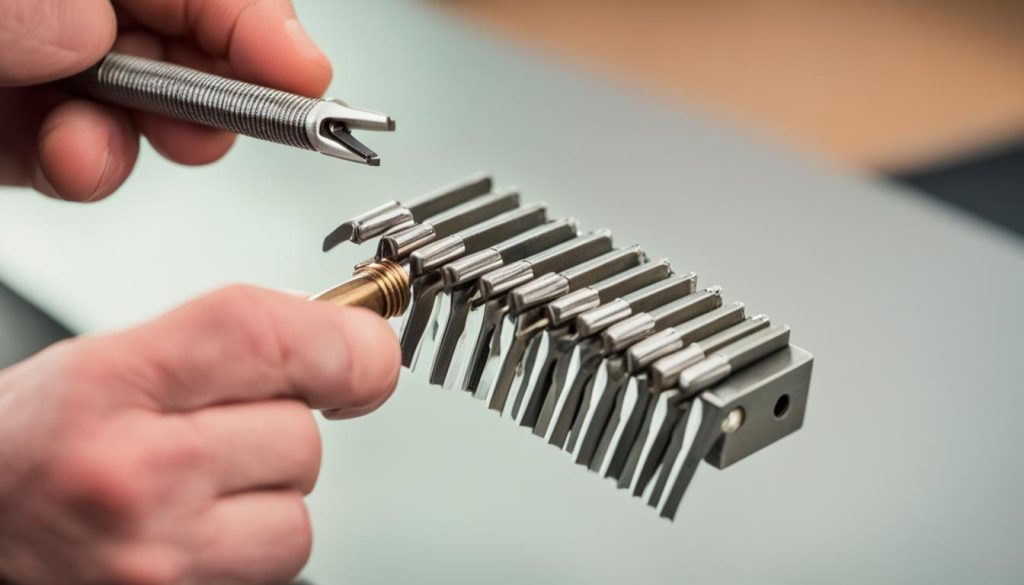
Remember, lock picking should only be used for legal purposes and with proper authorization. It’s essential to respect the laws and regulations regarding lock picking in your region.
Professional Lock Picking Techniques
When it comes to advanced locks, professional lock pickers rely on specialized tools and techniques to get the job done. To successfully pick high-security locks, having a comprehensive lock pick set that includes various picks and tension wrenches is essential. These tools are designed for precision and effectiveness, ensuring that every move helps in the process of unlocking the lock.
The Importance of a Lock Pick Set
A lock pick set is a valuable tool for professional lock pickers. It consists of different picks and tension wrenches that cater to various lock mechanisms. The picks are designed to reach specific pins and manipulate them with precision. The tension wrenches are used to apply rotational pressure on the lock’s core, allowing for the manipulation of the lock mechanism.
With a lock pick set, professionals have access to a wide range of tools that can be used for different types of locks, including cylinder locks, padlocks, and mortise locks. Each pick is carefully crafted to provide optimal performance in different scenarios, ensuring versatility and efficiency in lock picking.
Here is an example of a lock pick set that professionals may use:
| Tool | Description |
|---|---|
| Tension Wrenches | A variety of tension wrenches of different sizes and shapes to accommodate various lock types and keyways. |
| Hook Picks | Picks with a curved end for reaching and manipulating individual pins in a lock. |
| Diamond Picks | Picks with a diamond-shaped end that can be used to set pins quickly and efficiently. |
| Rake Picks | Picks with multiple ridges or bumps that can be used to quickly set multiple pins at once through rapid back-and-forth motion. |
| Circle Lock Picks | Specialized picks designed specifically for circle locks with unique mechanisms, such as tubular locks. |
These lock pick sets provide professionals with the necessary tools to tackle a wide range of locks and lock mechanisms, enabling them to handle complex locking systems with confidence and expertise.
Raking Techniques and Circle Lock Picks
Two advanced techniques widely used in professional lock picking are raking and the use of circle lock picks.
Raking involves inserting a specially designed rake pick into the lock and rapidly moving it back and forth, aiming to set multiple pins simultaneously. This technique is particularly effective for simple pin-tumbler locks, as it saves time and allows for quicker entry.
Circle lock picks are specialized tools used for locks with unique mechanisms, such as tubular locks. These picks have a circular shape with pins or springs extending around the circumference. By aligning and manipulating these pins or springs correctly, professionals can successfully unlock circle locks.
Important Note: Professional Lock Picking and Legal Considerations
It’s important to stress that professional lock picking should only be performed by trained and licensed individuals for legal purposes. Locksmiths and security professionals undergo extensive training and certification to ensure they possess the necessary skills and understanding of the applicable laws and ethics associated with lock picking.
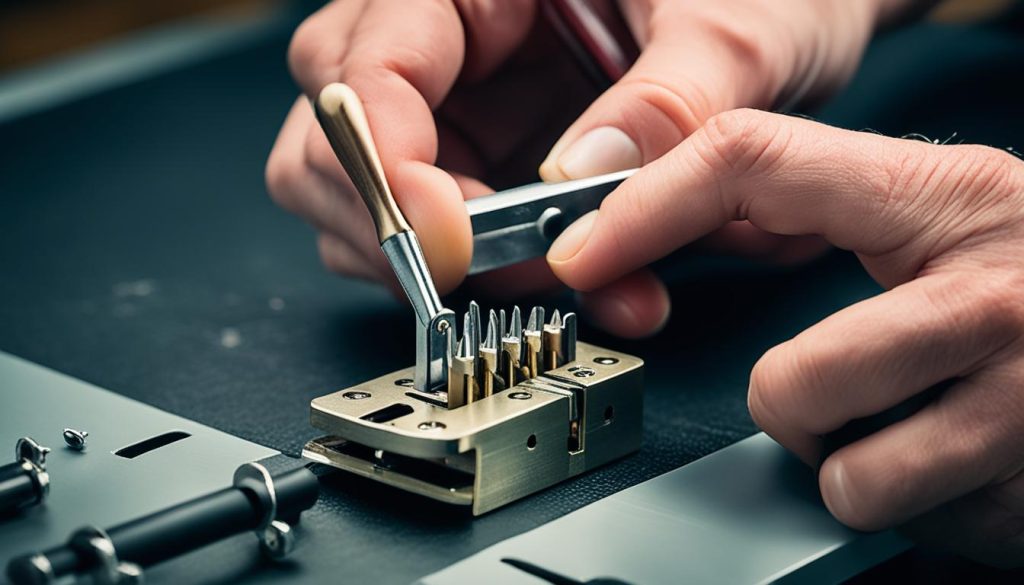
How to Open a Locked Door without a Key?
In situations where you are locked out and don’t have access to a key, knowing how to open a locked door can be a valuable skill. By following these lock picking tips and using the right lock pick set, you can successfully gain entry without a key. However, it’s essential to approach this skill responsibly and stay within legal boundaries.
To open a locked door without a key, you can use lock picking techniques to manipulate the lock mechanism and disengage the locking mechanism. Here are some tips to help you:
- Start by assessing the lock and its condition. Inspect the keyway and identify the type of lock you’re dealing with.
- Choose the appropriate lock pick set for the type of lock. Different locks may require different lock picking tools.
- Insert a tension wrench into the keyway and apply slight rotational pressure in the direction that the key would turn.
- Use a lock pick to manipulate the individual pins inside the lock, lifting them one by one until they reach the shear line.
- Continue lifting the pins while maintaining tension with the wrench until all pins are set.
- Apply more rotational pressure with the wrench, and the lock should turn, allowing you to open the door.
Remember, lock picking requires practice and finesse. It’s crucial to respect the laws and regulations governing lock picking in your region. Lock picking should only be done with proper legal authorization or in emergency situations where it’s your only option.
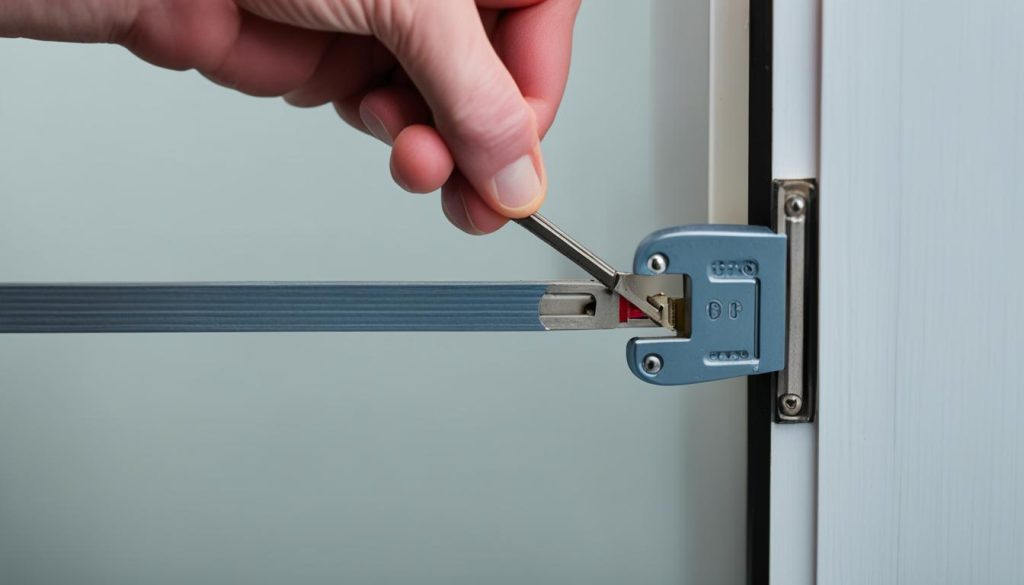
By following these lock picking tips and using a lock pick set, you can acquire the skills necessary to open a locked door without a key. However, always remember to use this knowledge responsibly and ethically.
Conclusion
Learning how to pick a lock can be a valuable skill for various purposes, such as understanding the functioning of locks, solving lockouts, and enhancing security measures. Lock picking techniques, when used responsibly and ethically, can help individuals gain practical knowledge about lock mechanisms and improve their locksmith skills. By practising these locksmith techniques, anyone can become proficient in lock picking.
It’s important to approach lock picking with responsibility and respect for the law. These techniques should only be used for legal purposes, such as in emergency situations or with proper authorization. Remember to always adhere to the laws and regulations regarding lock picking in your region to ensure you are not engaging in any illegal activities.
By familiarising yourself with different lock picking techniques and using the right tools, you can enhance your locksmith capabilities. However, it’s crucial to prioritize safety and ethical considerations when applying these skills. Lock picking should never be used to compromise the security of others or engage in any illegal activities. With dedication, practice, and a commitment to responsible use, you can develop the expertise necessary to navigate lock systems effectively.
FAQs
What tools do I need for lock picking?
A professional lock picking kit will have tools like tension wrenches, picks, and raking tools. Additionally, you can use household items like a bobby pin or a paperclip as a substitute for lock picking tools.
Can beginners pick locks?
Yes, beginners can start with household items like a bobby pin or a paperclip to practice lock picking. These techniques require practice and finesse to master.
Is it possible to open a locked door without a key?
Yes, it is possible to open a locked door without a key using lock picking techniques. By following the steps mentioned earlier and using the appropriate tools, you can successfully open a locked door.
Is lock picking legal?
Lock picking is legal in most regions for individuals with the right intentions, such as locksmiths or people who are locked out of their own property. However, it’s important to always respect the laws and regulations regarding lock picking in your specific area.

